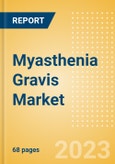Myasthenia Gravis (MG) is an autoimmune and neuromuscular disease that is characterized by muscle weakness and fatigue. In the majority of patients, the disease is initially localized and limited to the eye muscles, causing drooping of the eyelid (ptosis) and double vision (diplopia). This weakness can give patients difficulty controlling eye and eyelid movement, facial expressions, chewing, and talking. In some cases, the disease progressively begins to affect respiratory muscles. MG is considered to be the most common neuromuscular disorder, although it is still classified as a rare disease. The precise etiology of MG is idiopathic, and while factors such as infections are known to increase susceptibility, the specific cause is often indeterminable. The disruption of the normal communication between nerves and muscles at the neuromuscular junction is a key pathological process in MG, which results in impairment of the patient’s ability to engage in voluntary muscle movements.
Key Highlights
Report deliverables include a Pdf and an Excel-based forecast model
Forecast includes the 7 major markets (7MM)Forecast covers the period 2022-2032
Scope
- Overview of Myasthenia gravis disease, classification of Myasthenia gravis according to the Myasthenia Gravis Foundation of America guideline, etiology, pathophysiology, and epidemiology of Myasthenia gravis
- Current treatment options including product profiles for Myasthenia gravis marketed in the 7MM.
- Analysis of unmet needs and R&A strategies within the Myasthenia gravis market.
- Pipeline analysis including product profiles for leading candidates in the 7MM.
- Myasthenia gravis market outlook including revenue breakdown by market between the years 2022 and 2032
Reasons to Buy
- Understand the trends shaping and driving the Myasthenia gravis market
- Identify the innovative technologies and key players leading the Myasthenia gravis field
- Recognize gaps and areas of unmet need within the Myasthenia gravis market
- Determine the current and future outlook for Myasthenia gravis according to key opinion leaders (KOLs)
- Track Myasthenia gravis sales from 2022-2032
Table of Contents
Companies Mentioned (Partial List)
A selection of companies mentioned in this report includes, but is not limited to:
- Alexion
- AstraZeneca
- Argenx
- UCB
- Janssen Pharmaceuticals
- Horizon Therapeutics Plc
- Regeneron Pharmaceuticals
- Chugai Pharmaceutical Co Ltd
- Hoffmann-La Roche
- Immunovant Inc
- Alnylam Pharmaceuticals Inc








